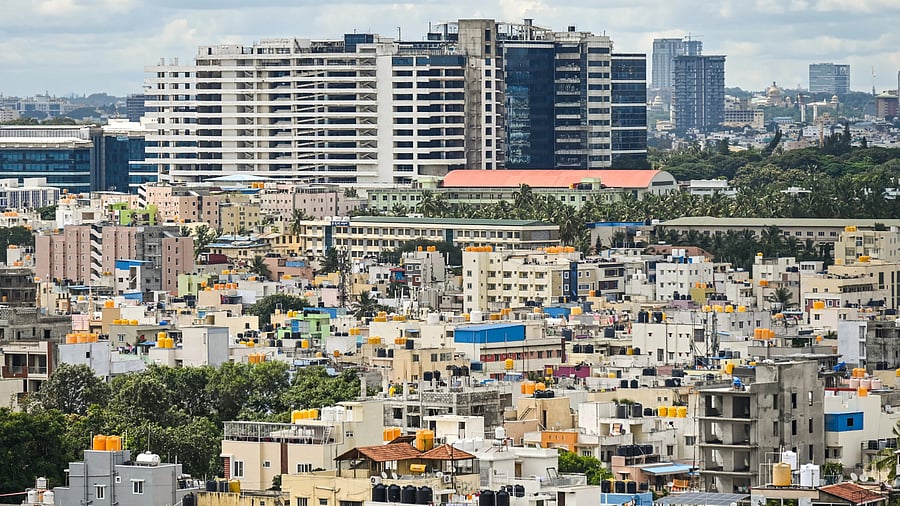
BBMP has proposed exempting buildings on plots under 1,200 sqft from occupancy certificates.
Credit: DH Photo/Pushkar V
Bengaluru: On July 17, the Bruhat Bengaluru Mahanagara Palike (BBMP) wrote to the state government proposing to exempt buildings constructed on plots smaller than 1,200 square feet from obtaining occupancy certificates (OC). The proposal — which requires amendments to the law — was made on the grounds that site inspections were overburdening staff, leading to delays and public harassment.
On average, the BBMP’s eight zones issue about 4,000 new building plan approvals every year for plots not exceeding 1,200 square feet. These plots are also covered under Nambike Nakshe, an automated online software that approves the draft sketch on the day of submission and provides final approval within 15 days.
Beyond simplifying building approvals, the civic body is now pushing to eliminate the requirement of obtaining OCs once the construction is completed. The BBMP has asked the state government to amend Section 241(7) of the Greater Bengaluru Governance Act, 2024 to allow the exemption.
The first major discussion on this proposal was held on July 3, in a meeting chaired by Chief Minister Siddaramaiah and attended by several ministers. The meeting was reportedly called to find solutions for those affected by the Supreme Court’s December 2024 order, which mandated that no civic services — water, electricity, or sanitation — be provided to buildings in violation of norms or lacking an occupancy certificate.
While the SC ruling was seen as a relief for Bengaluru, which has long grappled with rampant illegal construction amid lack of enforcement from authorities, it also affected property owners who had built as per the rules but were denied OCs simply because their plots were ‘B’ khata properties. The BBMP does not issue OCs for B khata sites, a policy deadlock that needs a separate fix.
Following the July 3 meeting, senior government officials began drafting the next course of action. They noted ground-plus-two or stilt-plus-three floor buildings on 1,200 sqft plots can be exempted from obtaining the occupancy certificate. Illegal constructions, they clarified, would continue to face consequences under the law. They also agreed with the BBMP’s view that inspections to verify whether the approved building plans matched the final structure were causing delays as the staff were overburdened with various responsibilities.
In addition, the civic body is preparing a proposal to increase permissible setback deviations from the existing 5% to 25%, with penalties levied on violators.
Nagarathpete in the making?
Citizen activists fighting against illegal constructions have warned that relaxing such regulatory checks could turn all of Bengaluru into Nagarathpete — a congested neighbourhood with narrow lanes, towering structures and no setbacks.
They recalled two recent tragedies, one in Wilson Garden and another in Nagarathpete. While the tragedies are not directly linked to building violations, activists argued that such incidents demonstrate how densely packed houses without setbacks can turn accidents into large-scale neighbourhood disasters and also pose challenges for rescue operations. In Nagarathpete, the fire personnel had a harrowing time not just in accessing the fire-hit building but also climbing the narrow stairs.
Smriti Tipirneni, an advocate residing in Cooke Town, recalled that the stretch where she lives has multiple buildings that appear to have exceeded the 21-metre height rule without securing the no-objection certificate from the fire department. “Even after complaints, no action followed. With the government now introducing further relaxations, including in setbacks that are critical for fire access, there is a real risk of replicating the safety failures of Nagarathpete across the city,’ she said.
When BBMP had taken up a city-wide survey earlier this year, it had found that two out of every third under-construction building it surveyed did not take the mandatory approvals to start the work. On top of this, it also found setback and height violations in 1,171 buildings. Even though the civic body has chalked out a three-month timeline to act against the violators, it has not been successful on the ground owing to multiple factors including ligitaionts.
R. Rajagopalan, convener of the BLR Coalition, reiterated that on small plots, unscrupulous builders already raise 7–8 floors illegally to meet demand for rentals and PG accommodations. “The recent collapses were stark reminders of why stricter enforcement is essential. Yet, promises have reduced to lip service, with lives already lost and quickly forgotten. Such amendments will only accelerate urban decay, worsen heat islands, and embolden violators,” he added. He also argued that granting amnesty to violators by amending the law would be ultra vires, since the Akrama Sakrama scheme is still stayed by the Supreme Court. “Exempting occupancy certificates will remove the only check ensuring buildings are compliant and safe for occupation. Public safety cannot be overstated,” he said.